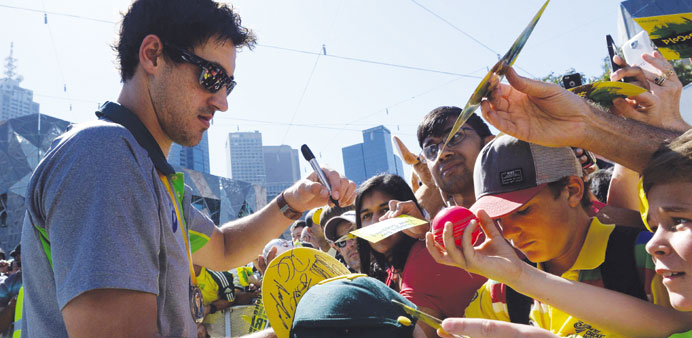Australian pacer Mitchell Starc signs autographs during a public event to celebrate his team's victory in the World Cup, in Melbourne yesterday. (AFP)
AFP/Melbourne
Amidst all the blazing hitting witnessed at the 2015 World Cup, the value of one of cricket’s enduring constants was proved again—nothing slows a run-rate quite like taking wickets.
Few matches better demonstrated this point than Australia’s dominant seven-wicket win over New Zealand in Sunday’s final in Melbourne.
Left-arm fast bowler Mitchell Starc, deservedly named man-of-the-tournament for a haul of 22 wickets at a stunningly meagre average of just over 10 runs apiece, summed up his brilliant six weeks in the final’s opening over.
The dynamic Brendon McCullum, New Zealand’s inspirational captain, couldn’t lay a bat on the first couple of balls he faced and was then yorked for a duck by an express Starc delivery off the third.
“What this World Cup has clearly shown is that a fast, full and straight yorker is a very good delivery,” tweeted former Australian paceman Jason Gillespie.
Starc was one of several left-arm quicks, including New Zealand’s Trent Boult, who also took 22 wickets, to star at this World Cup.
Both bowlers were well-supported by aggressive fields set by their respective captains in Australia’s Michael Clarke and McCullum, whose sides also showed the value of a genuine five-man attack.
Nevertheless, this tournament witnessed the most 300-plus and even 400-plus totals at a World Cup.
Crowds loved the big hits but many within cricket weren’t so sure, with the fielding restriction that means just four men are allowed outside the 30-yard circle in the last 10 overs under fire.
“In the old days you had one area you couldn’t defend, now there’s two and if a good batsman is set, as a bowler you’ve got very little price,” said ICC chief executive David Richardson.
“One of the things we might look at is allowing an extra fielder out of the ring in the last 10 overs...That might be a sensible change.”
New Zealand may have lost their maiden World Cup final but on the way they won eight straight matches and in so doing disproved the theory that in order to play good aggressive cricket, it is also necessary to verbally abuse or ‘sledge’ your opponents.
“New Zealand’s semi-final win over South Africa was a brilliant example of how you could play attacking, hard cricket and not worry about the man,” said Richardson.
The Black Caps also showed that with the ICC now being run by the ‘Big Three’ of India, Australia and England—whose dire effort in crashing out in the first round was no surprise—that talent, good organisation and strong leadership can help compensate for a small playing base and a lack of financial clout.
One crumb of comfort for England, who will host the 2019 tournament, was that the past two World Cups have now been won by the host nation in India and Australia.
Plenty of colour, excitement and no little skill was provided in the early stages by the four non-Test or Associate sides, with Afghanistan’s Shapoor Zadran, the UAE’s Shaiman Anwar and Scotland’s Josh Davey all making a name for themselves.
Meanwhile Ireland, for the third World Cup in a row, enjoyed success against Test nations with wins over the West Indies and Zimbabwe.
Yet, as things stand—despite Richardson leaving the door open to change—the 2019 World Cup will feature 10 teams (the same number as there are Test nations) rather than this year’s 14.
Remarkably, the next World Cup is scheduled to last slightly longer than the 44-day marathon of 2015 as there will be more ‘marquee’ matches demanding prime-time television slots.
Richardson made the point that the game must do more for the Associates between World Cups, but what is the long-term future for cricket in those countries if they do not have a realistic chance of playing in the sport’s showpiece tournament?
In 2017, the top eight-ranked sides in the ICC’s standings will gain direct entry to England 2019.
The bottom four, in a list that will now include Afghanistan and Ireland, will play in a 10-team 2018 qualifier to determine the last two teams involved.
“The Associates will still have a meaningful chance,” ICC chairman Narayanaswami Srinivasan told Fox Sports during the final.
A record Melbourne Cricket Ground crowd of more than 93,000 made their feelings known by booing Srinivasan at the presentation ceremony.

